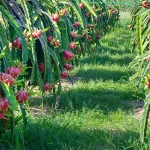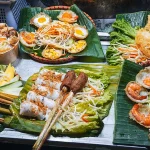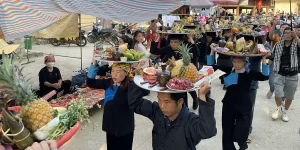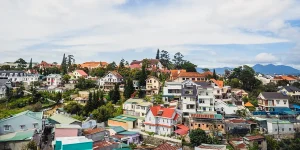Vegetarian food in Vietnam comes from long Buddhist traditions that shaped cooking habits across many regions. Modern cities developed this base further through cafés, buffets, and plant-focused restaurants.
Travelers now find Vietnamese vegetarian dishes in busy commercial districts, local markets, and temple areas. The range varies by region, yet the overall network remains broad enough for most trips.
Vietnam’s vegetarian scene splits neatly into three styles:
- Traditional vegetarian eateries beside temples serve home-style plates of rice, soup and vegetables for ~40,000 VND ($1.60 / €1.50). Plastic tables, fast service, authentic flavour.
- All-you-can-eat vegetarian buffets offer twenty to fifty dishes for ~140,000 VND ($5.60 / €5.20).
- Modern vegetarian cafés in tourist and trendy districts provide air-conditioning, English menus and refined plating for ~180,000 VND ($7.20 / €6.70) on average.
Table of Contents
Fun Fact
Many Vietnamese who eat meat daily follow vegetarian meals on key lunar dates.
The most common days are the 1st and 15th of each lunar month.
The habit comes from Mahayana Buddhist practice and family tradition.
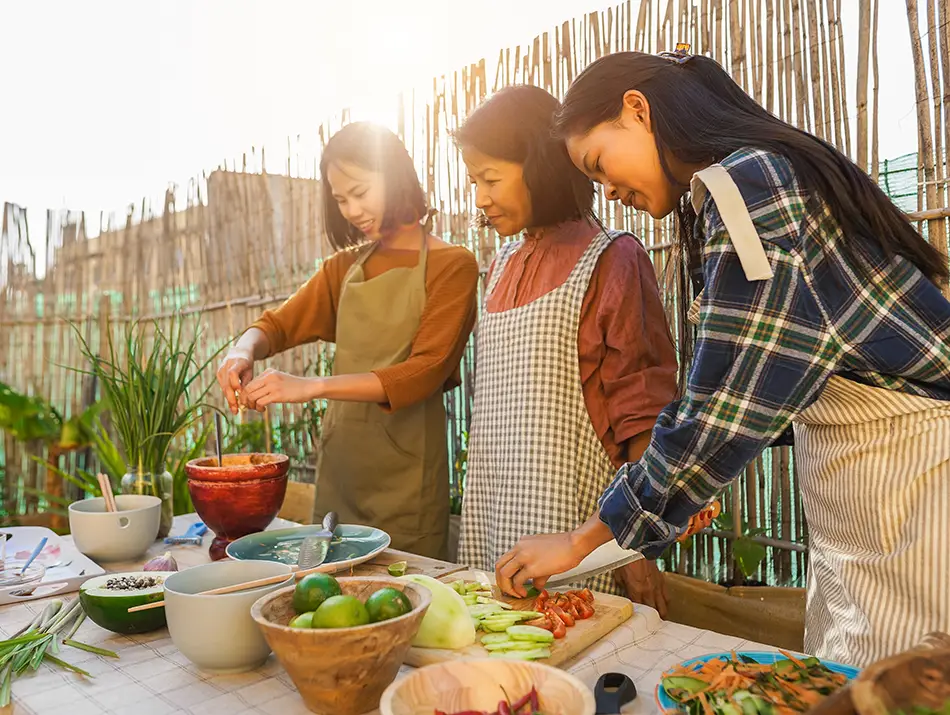
Is It Easy to Find Vegetarian Food in Vietnam?
Major cities make vegetarian eating straightforward. Ho Chi Minh City alone lists over 450 fully vegetarian or vegan restaurants on review platforms in 2025. Hanoi follows close with more than 250.
Rural areas and small towns require more effort, however. You might find only one or two vegetarian places, usually attached to the local temple or market.
Understanding “Chay”: Vietnam’s Vegetarian Tradition
“Chay” is the Vietnamese word for vegetarian food. In the Buddhist tradition, it means no meat, no fish, no eggs, and often no garlic, onion, or strong spices — the same rules monks follow every day.
Today, most chay restaurants are regular eateries open to everyone. They replace meat with tofu, seitan, mushrooms, and young jackfruit to mimic the textures of classic dishes. Thanks to this system, travelers can walk in almost anywhere with a “chay” sign and eat with confidence.
Useful Vietnamese Phrases for Ordering Vegetarian Food
Start with the main phrase: “Tôi ăn chay” – pronounced toy an chai (I eat vegetarian).
Then add these extras for safety:
“Không nước mắm” – pronounced kohng nook mum (no fish sauce).
“Không trứng” – pronounced kohng troong (no eggs).
“Chỉ rau củ” – pronounced chee row koo (only vegetables and tofu).
Staff in cities and tourist spots usually understand these words instantly. Still, open Google Translate or a notes app with the phrases written in Vietnamese script – just showing the screen removes almost all mistakes.
Ingredients to Double-Check
Fish sauce is added to ~90 % of non-chay dishes — even simple morning glory stir-fry, mixed vegetable plates, or clear soups at local eateries. Dipping sauces for fresh spring rolls and broken rice almost always contains it.
Broths are the biggest trap: regular soups are simmered for hours with beef, pork, or chicken bones. Even “vegetable noodle soup” (bún rau củ) at normal stalls usually starts with animal stock unless the menu says “nước dùng chay” (vegetarian broth).
Eggs commonly appear in:
- Fried rice – one or two eggs are scrambled in by default.
- Crispy pancakes – eggs are mixed into the batter in central and southern versions.
- Quang-style noodles (mì Quảng) – a raw or soft-boiled quail egg is often cracked on top.
- Steamed rice rolls (bánh cuốn) – some places add minced pork and a fried egg.
Rule of thumb: in any restaurant without the word “chay” on the sign, assume everything liquid or saucy contains an animal product until proven otherwise. Ask twice and watch the cook if possible.
Fun Fact
Vietnam’s “mock meat” culture existed long before it became trendy abroad.
Tofu, wheat gluten, taro, banana blossom, and mushroom-based meats have been used for over 1,000 years in Buddhist cuisine.
Best Vegetarian Vietnamese Dishes to Try
Naturally Vegetarian

These staples rely on fresh vegetables, herbs, rice, and tofu as their core ingredients. They appear in everyday home cooking and street stalls without any meat or fish adaptations needed.
- Gỏi đu đủ – Shredded green papaya salad mixed with carrots, basil, coriander, peanuts, and a lime-soy dressing. Crunchy texture with tangy, nutty flavors. A refreshing side common in central Vietnam.
- Rau muống xào tỏi – Water spinach (morning glory) stir-fried with garlic and light soy sauce. Simple, garlicky greens that serve as a daily side. Widely available nationwide for 20,000–40,000 VND ($0.80–1.60/€0.75–1.50).
- Cà chua nhồi đậu hũ – Whole tomatoes stuffed with seasoned mashed tofu, braised in a light tomato sauce. Soft, savory filling with juicy tomatoes; a southern home-style comfort dish often paired with rice.
- Đậu hũ kho nấm rơm – Firm tofu and straw mushrooms braised in coconut water, black pepper, and soy. Tender, mildly sweet stew that’s a classic family meal. Found in markets for under 50,000 VND ($2/€1.85).
- Cải xào nấm – Bok choy stir-fried with shiitake mushrooms and soy. Earthy mushroom notes with crisp greens; a staple side in northern eateries, enhanced by sticky rice.
- Xôi chay – Steamed glutinous sticky rice topped with mung beans, sesame, or peanuts. Chewy, mildly sweet breakfast option; street vendors sell it hot for 25,000 VND ($1/€0.90), no meat ever added.
- Gỏi xoài – Green mango salad with jicama, mint, chili, and lime dressing. Bright, sour-spicy crunch; a light northern snack, often with added herbs but always plant-based.
Iconic Vietnamese Dishes in Vegetarian Variations

These classics typically feature beef, pork, shrimp, or fish sauce in their standard forms. Chay versions swap in tofu, mushrooms, or mock meats while keeping regional flavors intact.
- Phở chay – Rice noodle soup in aromatic vegetable-mushroom broth with star anise, tofu, king oyster mushrooms, and fresh herbs. Warm, spiced comfort; northern staple adapted from beef pho, served everywhere for 50,000–80,000 VND ($2–3.20/€1.85–3).
- Bún chả chay – Grilled tofu or seitan patties over vermicelli noodles with pickled vegetables, herbs, and nuoc cham dipping sauce. Smoky, tangy Hanoi classic; meatless twist keeps the grilled essence.
- Bánh xèo chay – Crispy turmeric rice pancake filled with bean sprouts, mushrooms, and tofu, wrapped in lettuce. Sizzling southern crepe; original has shrimp, but chay version crisps up for 60,000 VND ($2.40/€2.20).
- Canh chua chay – Tamarind sour soup with pineapple, tomato, okra, bean sprouts, and elephant ear stem in vegetable broth. Tangy, fruity Mekong Delta staple; skips fish for pure plant acidity.
- Bánh cuốn chay – Steamed rice sheets rolled with wood-ear mushrooms and shallots, topped with crispy shallots and soy. Delicate northern rolls; pork-free filling maintains the silky texture.
- Cơm tấm chay – Broken rice with pickled vegetables, cucumber, tomato, scallion oil, and braised tofu. Hearty southern breakfast plate; replaces pork ribs with mushrooms for everyday appeal.
- Bún riêu chay – Tomato-based noodle soup with tofu puffs, tamarind, and banana blossom. Sour-spicy central dish; crabless version uses fermented tofu for umami depth.
Check out the Best dishes to try in Vietnam guide to discover more iconic Vietnamese classics and learn how to order their delicious vegetarian versions.

Vegetarian Street Food in Vietnam
All these are sold daily from carts, small stalls, or market corners and are either naturally vegetarian or have reliable chay versions with no meat added.
- Bánh mì chay – Baguette sandwich stuffed with pickled carrots, cucumber, coriander, chili, and grilled tofu or pate. Crispy French-Vietnamese fusion. Vietnamese street food icon from the south, available for 30,000 VND ($1.20/€1.10).
- Bột chiên chay – Cubed rice-flour cakes pan-fried until golden and chewy, served with green papaya slaw and soy-vinegar dip. Saigon night-market classic.
- Xôi chay / xôi ngô – Sticky rice steamed with mung beans or sweet corn, topped with sesame salt or coconut.
- Bánh bèo chay – Tiny steamed rice cakes in ceramic dishes, topped with mung-bean paste, crispy shallots, and scallion oil. Central (Hue) specialty.
- Bánh nậm chay – Flat steamed rice dumplings wrapped in banana leaf, filled with mung bean and mushroom. Hue street staple.
- Nem chay cuốn – Fried spring rolls with taro, carrot, mushroom, and glass noodles. Served with sweet chili or peanut sauce.
- Hạt sen rang – Fresh lotus seeds lightly salted and roasted in a wok right in front of you. Sweet, nutty, and addictive.
Fun Fact
Lotus is a sacred plant and a common vegetarian ingredient. Vietnam uses every part of the lotus in vegetarian cooking: stems in salads, seeds in desserts, leaves for wrapping rice, roots in soups, and blossoms for tea.

Where to Eat Vegetarian Food in Vietnam
The restaurants below are reliable, popular picks with English menus and consistent quality – perfect when you want certainty. Still, the most memorable vegetarian meals in Vietnam often come from tiny unmarked chay stalls next to temples, hole-in-the-wall buffets on lunar days, or family-run spots without a single review online.
Keep your eyes open for the word “chay” on any sign, and you’ll almost always discover the best food and the lowest prices. Use the recommendations here as a safety net, but let local exploration lead the way.
Ho Chi Minh City
Hum Signature – beautiful setting, refined Vietnamese vegetarian dishes.
Zen Vietnamese Vegan House – modern, creative plates, great mock meats.
Hanoi
Uu Dam Chay – classic temple-style near West Lake, calm atmosphere.
Ivegan Supershop Westlake – fully vegan, Western-Vietnamese fusion, good coffee.
Da Nang
Ivegan Supershop Da Nang – big menu, air-con, reliable.
Dalat
Lau chay Hang Thien – vegetarian hot-pot restaurant.
An Lac Tam Chay – simple, cheap, authentic, near the market.
Hue
Lien Hoa Vegetarian – long-established local favorite serving classic Hue vegetarian dishes; affordable and central.
Thanh Lieu Vegetarian – simple, busy lunchtime spot known for flavorful home-style chay plates.
Fun Fact
Hue is often called Vietnam’s vegetarian capital. As the former imperial seat and a major Buddhist center, the city developed around 125 unique vegetarian dishes. Many of these “royal chay” recipes, once created for temple offerings and the Nguyễn Dynasty court, are still served today.
Apps to Locate Vegetarian Spots in Vietnam
HappyCow
HappyCow is the easiest tool for finding vegetarian food in Vietnam. The platform lists over 1,200 vegetarian and vegan restaurants across the country, including temple kitchens, small chay eateries, and modern cafés. Filters help you spot fully vegetarian places, buffet-style restaurants, or street-food options in seconds.
Google Maps
Google Maps works well for quick local searches, especially in smaller towns. Most family-run chay spots appear on Maps even if they have no website or reviews. Search “chay” to find hidden neighborhood places. Offline maps also help when traveling through rural areas where mobile signal is weak.

FAQ: Vegetarian Travel in Vietnam
Yes — easier than almost anywhere else in Southeast Asia. Over 1,500 dedicated chay restaurants and cafés are listed in 2025. Ho Chi Minh City has 500+, Hanoi 300+. Outside big cities, look for temples or the word “chay” on green signs — every town has at least one.
Main phrase is “Tôi ăn chay” (toy an chai).
Rau muống xào tỏi (garlic morning glory), Cà chua nhồi đậu hũ (tofu-stuffed tomatoes), Đậu hũ kho nấm rơm (braised tofu & straw mushrooms), Chè bà ba (taro & coconut sweet soup)
Yes. Most savory dishes rely on fish sauce, meat broth, or pork fat. Even plant-based dishes may use these ingredients unless labeled chay.
Final Tips for Vegetarian Travelers in Vietnam
Learn the word “chay” – it becomes your best friend. Download HappyCow and Google Translate offline. Visit temples on the 1st or 15th lunar days for the widest choice and lowest prices.
Vietnam continues to surprise vegetarians with new cafés opening every year. Move beyond pho chay and try regional specialties in each city – the variety rewards curious eaters.
You can explore more destinations and topics by visiting our complete Vietnam travel guides page.
Safe and happy plant-based travels!

